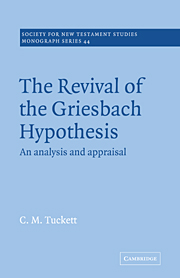Summary
The subject of this book is the contemporary revival of the Griesbach hypothesis, i.e. the hypothesis that, of the three synoptic gospels, Matthew was written first, Luke was written second in dependence on Matthew, and finally Mark was written using both Matthew and Luke. This old hypothesis about the relative order of the gospels has been revived recently by a number of scholars, notably by W. R. Farmer. Farmer's main contribution to the debate has been the publication of his book The Synoptic Problem in 1964, and since then he has indicated his continuing belief in the Griesbach hypothesis in a number of other articles. Other studies have brought forward additional arguments which might support the Griesbach hypothesis from a number of different angles: these include the works of G. W. Buchanan, O. L. Cope, D. L. Dungan, T. R. W. Longstaff, B. Orchard and H. H. Stoldt. (See the bibliography for details.) Farmer's work has aroused a new interest in the Synoptic Problem, and doubts have been raised about how firmly the traditional solution, i.e. the two-document hypothesis, is based. By the ‘two-document hypothesis’ is meant the theory that Mark was written first and was a common source for Matthew and Luke, and that the latter two gospels also made independent use of common source material, usually abbreviated as ‘Q’. This hypothesis was developed during the middle of the nineteenth century, and since then has received widespread acceptance.
- Type
- Chapter
- Information
- Revival Griesbach Hypothes , pp. 1 - 2Publisher: Cambridge University PressPrint publication year: 1983

